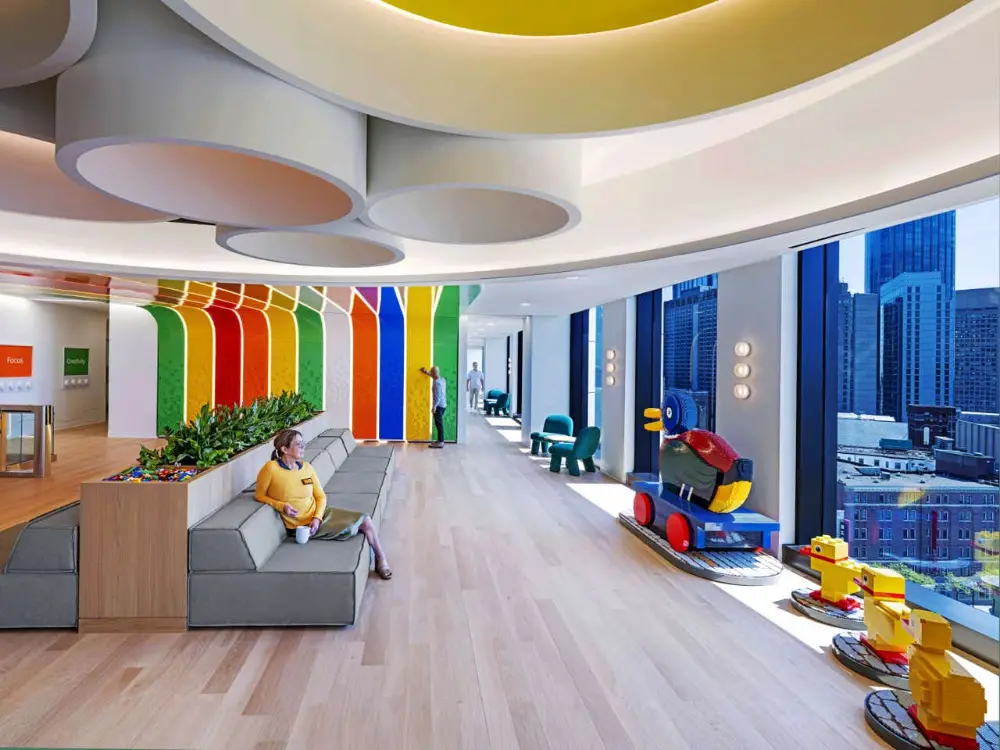The LEGO Group’s new, 157,000 s.f. U.S. Hub in Boston, Massachusetts is just the latest example of the world’s largest toy company’s increasing its investment in its North American operations.
According to a press release on the LEGO Group’s website, “the new state-of-the-art office will be the company’s new U.S. Hub and support its ongoing commitment to reaching more children across the U.S. with LEGO® play.”
The opening of the Danish toymaker’s new U.S. headquarters signals the beginning of the end for its former Connecticut headquarters, which the company has occupied for more than 50 years.

"This fantastic new LEGO® workspace is an important part of our US investment strategy, fast becoming a talent magnet in this important market,” said LEGO Group CEO Niels B. Christiansen. “The Boston Hub will open up new ways for LEGO colleagues to create, connect, and grow as we continue our mission to inspire and develop the builders of tomorrow across the US.”
The LEGO Group’s new HQ is LEED Gold and WELL Gold certified and features over 660 workstations, complimentary gym access, parents’ rooms and flexible wellness areas for employees to engage in activities like medication, prayer and relaxation, playful common spaces, sky terraces, and over 90 meeting spaces.
Over 800 employees will work out of the six-floor office, which was built by Structure Tone and designed by BDG, and is situated in the Lyrik, a 20-story office building completed last year.
Ryan Megenedy, senior account executive at Structure Tone, acknowledged in an interview with Engineering News-Record that building a space for a company like the LEGO Group “required a lot of creativity.”
“Many elements of the design echo the ‘studs’ on the iconic LEGO brick, which means we were working with a lot of curves and radiuses,” Megenedy explained in an email to ENR. “We also built four central staircases across five floors that enabled us to incorporate lots of fun and playful LEGO models throughout the space. We’re incredibly proud of how it turned out.”
In addition to its new U.S. headquarters, the LEGO Group is also opening a 2,000,000 s.f. regional distribution center (RDC) in Prince George, Virginia, which will support a future factory in Greater Richmond. Both facilities are currently under construction and expected to open in 2027.
In a press release announcing those projects, the LEGO Group said they are part of the company’s global supply strategy to locate factories and distribution centers close to major markets and ensure capacity to support future growth in the region.
The RDC will be the second in the company’s Americas network, joining an existing center in Fort Worth, Texas. It will be operated by a third-party logistics partner, creating 305 jobs. The factory will create more than 1,700 jobs with the LEGO Group once fully operational.
“The regional distribution center will bring greater flexibility to our network, ensuring we are well positioned to support long-term growth in the Americas,” said Carsten Rasmussen, Chief Operations Office of the LEGO Group. “Together with our future Virginia factory, the RDC will shorten our supply chain in the region – reducing lead times for our customers as well as our environmental impact. We are grateful for the continued support from the Commonwealth of Virginia.”
Whether you’re building a 2,000,000 s.f. distribution center, a multi-story office space, or a skyscraper, GPRS can support your construction project through our comprehensive suite of subsurface damage prevention, existing conditions documentation, and construction & facilities project management services. We offer precision concrete scanning and utility locating, pinpoint-accurate leak detection, NASSCO-certified sewer line inspections, 2-4mm accurate 3D laser scanning, and in-house mapping & modeling tailored to your project’s specific needs.
All this accurate, actionable data is at your fingertips 24/7 thanks to SiteMap® (patent pending), GPRS’ project & facility management application that provides accurate existing conditions documentation to protect your assets and people.
From skyscrapers to sewer lines, GPRS Intelligently Visualizes The Built World® to help keep you on time, on budget, and safe.
What can we help you visualize?
Frequently Asked Questions
Will I need to mark out the utilities that GPRS locates?
GPRS will locate and mark all utilities for you. We have a variety of tools and markers we can use to highlight the locations of utilities, underground storage tanks and whatever else may be hiding.
What is the difference between a design intent and as-built model?
DESIGN INTENT – deliverables will be shown as a "best fit" to the point cloud working within customary standards, such as walls being modeled 90 degrees perpendicular to the floor, pipes and conduit modeled straight, floors and ceilings modeled horizontal, and steel members modeled straight. This will produce cleaner 2D drawings and will allow for easier dimensioning of the scan area. The deliverables will not exactly follow the scan data to maintain design intent standards. Most clients will want this option for their deliverables.
AS-BUILTS – deliverables will be shown as close as possible to actual field capture. If walls are out of plumb, pipes and conduit show sag, floors and ceilings are unlevel, steel members show camber, etc., this will be reflected in the model. This will produce reality-capture deliverables, but 2D drawings may show “crooked” or out of plumb lines, floors will be sloped or contoured, steel members may show camber, twisting or impact damage. Dimensioning will not be as easy due being out of plumbness/levelness, etc. This option should be used when the exact conditions of the scan area is imperative. Clients using the data for fabrication, forensic analysis, bolt hole patterns, camber/sag/deformation analysis, and similar needs would require this option.



.svg)